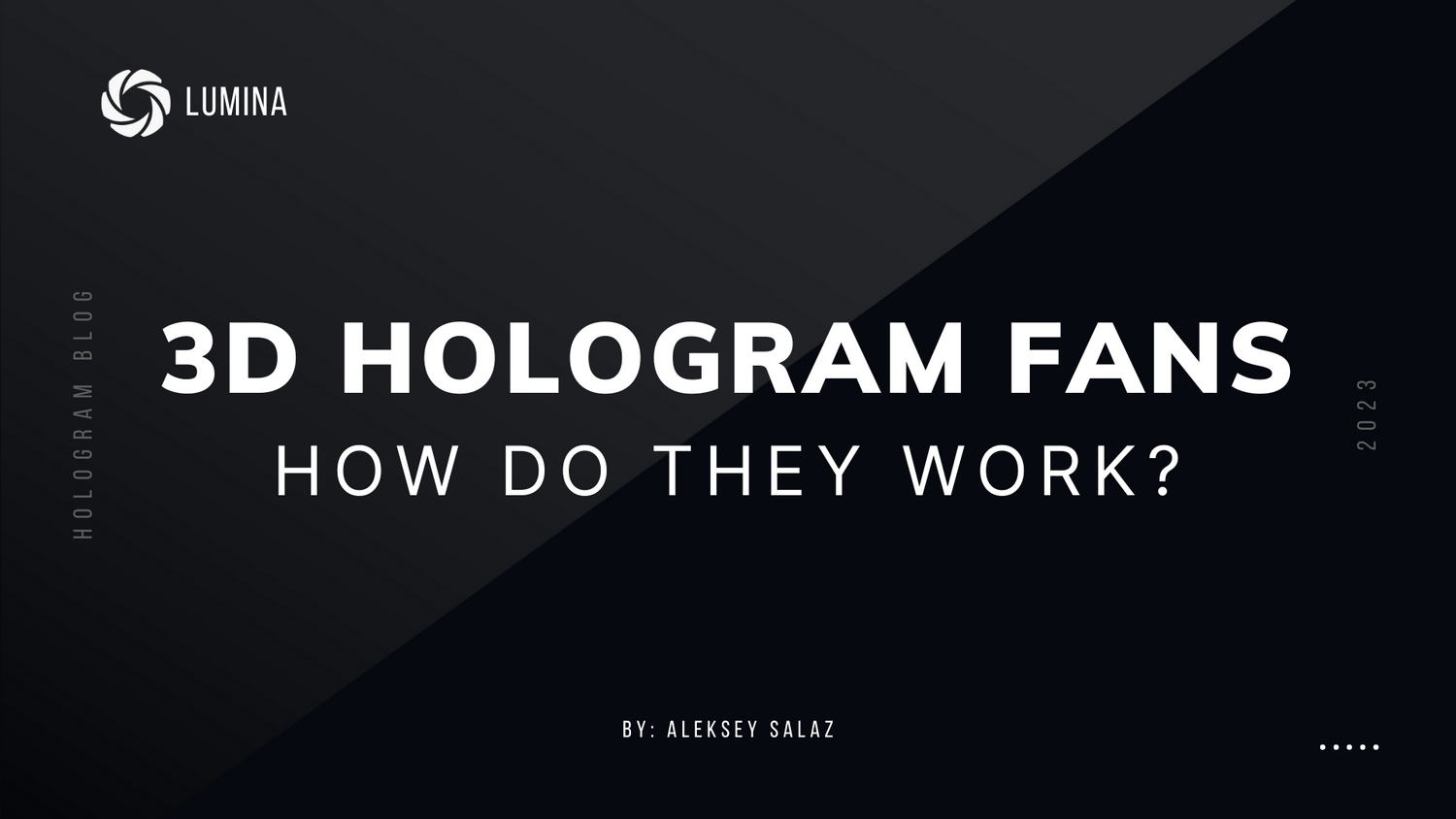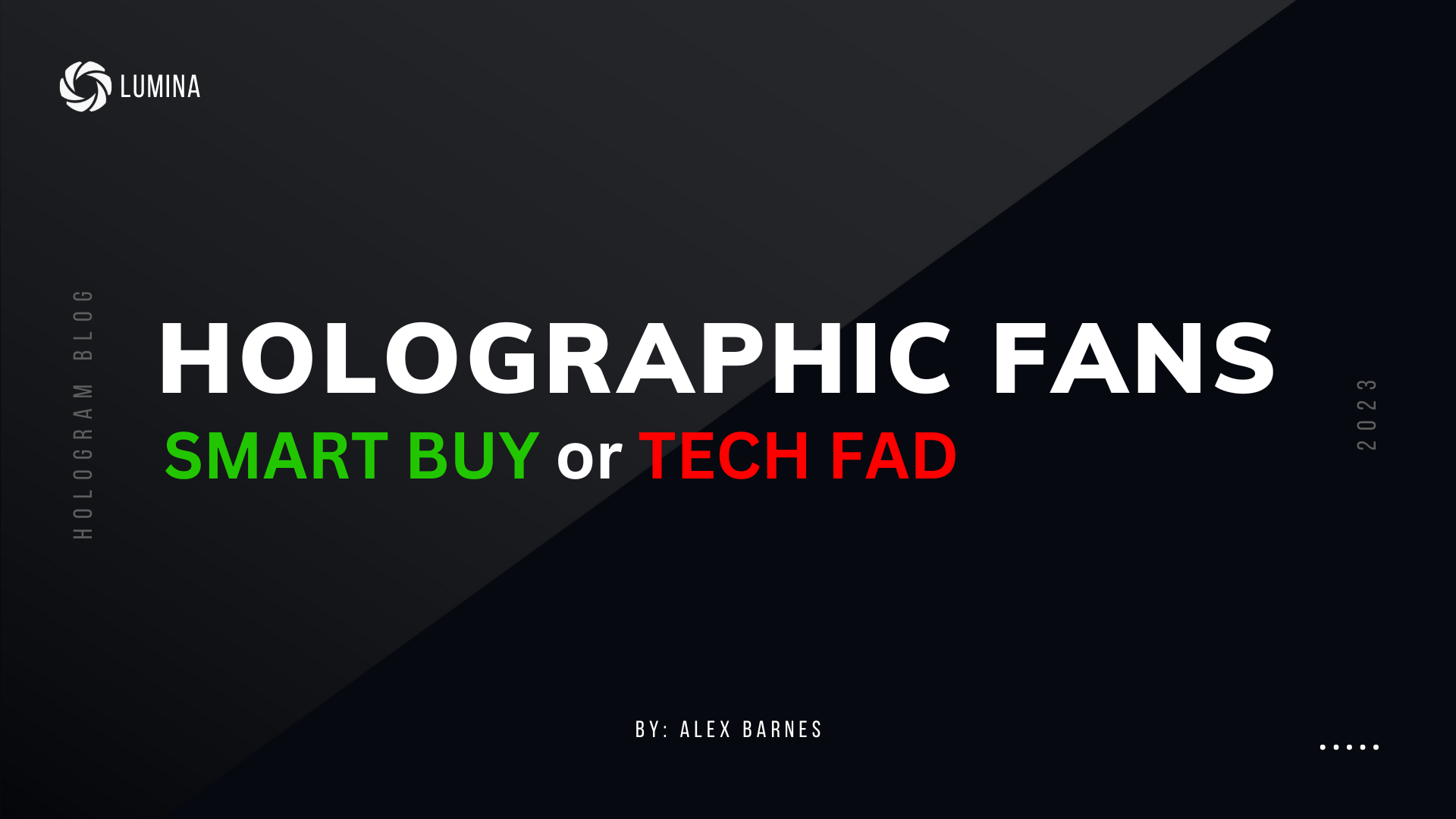Have you ever walked into a room and found yourself mesmerized by a floating logo, animated character, or a 3D model floating right before your eyes? Well, no, you haven't stepped into a sci-fi movie. You've just experienced the magic of a hologram fan.
At Lumina, our hologram fans work by:
- Utilizing a high-speed motor to spin a fan blade embedded with LED lights.
- Flashing these lights in a precise sequence to create a visual display.
- Creating a three-dimensional illusion in thin air through a phenomenon known as the 'persistence of vision' (POV).
We know these concepts sound high tech, but you don't need to be a tech guru to understand how it all works. This article aims to guide you through the fascinating universe of hologram fan technology, breaking down its complex workings into simple, understandable chunks of knowledge.

Don't worry, by the end of this journey, you won't just understand how hologram fans work but will also appreciate the intricate blend of science and technology that allows 3D images to just hang in the air as if by magic. Ready to unravel this mystery? Let's dive in.
Understanding the Basic Working Principle of Hologram Fans
The question "how does a hologram fan work" is best answered by breaking down its fundamental components and their roles in creating the mesmerizing 3D visual displays.
The Role of High-Speed Motor and LED Lights
At the heart of a hologram fan lies a high-speed motor. This motor's role is to spin a specially designed fan blade at speeds often exceeding 400 RPM. But these aren't your average fan blades. They are embedded with programmable LED lights capable of flashing in a sequence at microsecond intervals. These lights can produce a wide spectrum of colors, adding to the visual appeal of the display.
This quick rotation coupled with the fast-flashing LED lights is what creates the illusion of a 3D image. A separate controller, often a microcontroller or a digital signal processor (DSP), is responsible for synchronizing the flashing of LED lights with the fan's speed. This precise synchronization is crucial. It ensures the creation of a convincing 3D image that doesn't flicker or appear unstable.
The Persistence of Vision Phenomenon
But how does the human eye perceive these fast-flashing lights as a continuous, stable image? That's where the Persistence of Vision phenomenon comes into play. This is a quirk of human vision where an afterimage lingers in our eye for a fraction of a second. The rapid flashing of LED lights, combined with the fan's high-speed spin, exploits this phenomenon to create a continuous, stable image.
Take a quick look at a spinning bicycle wheel. When it spins fast enough, you stop seeing the individual spokes and instead see a continuous disc. That's a simple demonstration of the Persistence of Vision phenomenon.
The frame rate of the video content being displayed plays a significant role in creating a stable image. This rate must be synchronized with the speed of the fan. Any mismatch in these rates can result in flickering or unstable visuals, disrupting the 3D effect.
In the next section, we'll dive deeper into the science behind hologram fans, discussing transmission and reflection holograms, and how light plays a crucial role in creating these captivating displays.
The Science Behind Hologram Fans
In order to truly understand how does hologram fan work, delve into the scientific principles that underpin their operation.
Transmission and Reflection Holograms
Holograms are majorly of two types: transmission and reflection holograms.
Transmission holograms are created when monochromatic light, or light of a single wavelength, passes through them. This interaction produces a 3D image that appears to float in space, much like the images created by our holographic fans.
On the other hand, reflection holograms produce a 3D image when laser light or white light reflects off their surface. This type of hologram was introduced by Yuri Denisyuk from the Soviet Union, contributing significantly to the development of holography.
The Power Source: Laser
The laser is the heart of modern holography, acting as its primary light source. In a typical holographic setup, a laser beam is split into two. One beam, known as the object beam, is directed onto the object and then onto the recording medium. The second beam, known as the reference beam, is directed straight onto the recording medium. The interference pattern created by these two beams interacting produces the hologram.
This process requires a coherent light source, and lasers are perfect for this due to their ability to produce a narrow, intense beam of light of a single wavelength. The development of the laser by Theodore H. Maiman in 1960 was a crucial milestone, providing the coherent light source necessary for creating clear holograms.
The Role of Light in Creating Holograms
Light plays an indispensable role in the creation of holograms. Holography is fundamentally based on the principles of interference and diffraction to record and reproduce a 3D light field. This means that when the laser light illuminates the hologram, it is diffracted by the hologram to produce a light field identical to that which was produced by the original scene. This light field then enters the eye just as if it were light coming straight from the scene itself, creating a truly 3D view.
In spinning LED holograms, light is used in an innovative way. By spinning a fan blade embedded with LED lights at high speed, and flashing these lights in a specific pattern, a stable, continuous image can be created. This is thanks to the persistence of vision phenomenon, which makes our eyes perceive the rapid sequence of flashing lights as a single, unified image.
In the next section, we'll discuss how these principles are applied in the design and construction of our holographic fans.

Sources:
The Design and Construction of Hologram Fans
Understanding how does hologram fan work goes beyond its principle of operation. It's also crucial to grasp the design elements and construction materials that make these incredible displays possible. Let's delve into some key aspects of our Lumina hologram fans.
The Use of Polycarbonate Sheets for Fan Blades
The fan blades aren't just your typical blades. We construct them using polycarbonate sheets, a lightweight yet durable material. This choice of material ensures that our fan blades can withstand the high speeds of rotation, often exceeding 400 RPM, necessary to create the illusion of a 3D image (Lumina).
The Programmable LED Lights
LED lights play a crucial role in our hologram fans. They're not there just for illumination; they're programmable! Capable of producing a wide spectrum of colors, these LED lights flash in a precise sequence at microsecond intervals. When synchronized with the fan's speed, these rapidly flashing lights create a stable visual display.
Safety Measures: Protective Covers and Cages
We understand that the safety of our users is paramount. Given the high speeds at which the fan blades spin, we've installed protective covers or cages to prevent accidental contact. Touching an active holographic fan is not recommended, and these safety measures help ensure that the fan can operate safely while you enjoy the mesmerizing 3D visuals (Lumina).
As we continue to explore the magic behind hologram fans, it's clear that the fusion of careful design, advanced technology, and user safety considerations is what makes these devices so unique and captivating. In the next section, we'll discuss the practical applications of hologram fans, so stay tuned!
Practical Applications of Hologram Fans
Understanding how does hologram fan work is just the beginning. Now, let's delve into the practical applications of this innovative technology, and see how it can be a game-changer for businesses and events.
Advertising and Marketing
The captivating 3D visuals produced by hologram fans have a significant role in the realm of advertising and marketing. When grabbing customer attention is essential, these fans offer a fresh, high-tech tool for brands. They can be used to highlight products and services in an engaging way, making them stand out from typical 2D advertisements. As Colby C., a manager, testified, these fans drew more people to their trade show booth, resulting in more leads.
Presentations and Trade Shows
Presentations and trade shows are all about making an impact, and the 3D hologram fans can make that happen. With their ability to create the illusion of floating 3D objects, these fans add a wow factor to any event, drawing in audiences and sparking conversations. Imagine showcasing your products or data in 3D, right in the middle of your booth or stage. It’s not just about showing information, it’s about creating an unforgettable experience.
Custom 3D Displays with Lumina
At Lumina, we offer more than just the hardware. We provide an opportunity for businesses to create custom 3D animations for their hologram fans. Whether you need to transform your brand logo, product images, or messages into 3D displays, our team of graphic artists and animators are ready to assist. The potential applications are vast, from retail spaces and trade shows to special events and installations (Lumina).
We believe in the power of 3D hologram fans to revolutionize visual content, not just as a cool gadget but as a tool that can make your brand more engaging and interactive. With a better understanding of how they work and their practical applications, you might find 3D hologram fans to be the perfect fit for your next project or event.
Stay tuned for the next section where we'll delve into the future of hologram fan technology.
The Future of Hologram Fan Technology
In the ever-evolving world of display technology, we're constantly working towards enhancing the user experience. The future of 3D hologram fans promises even more exciting advancements.
Low Power Consumption and Noise Level
One of the key factors that make our hologram fans stand out is their eco-friendliness. Despite the high-speed action of the blades and the brilliant LED lights, these fans are surprisingly power-friendly.
The secret lies in our use of advanced LED technology and brushless motors, which keeps the power consumption to a minimum. This not only makes our fans a budget-friendly choice, but it also contributes to reducing your carbon footprint.
In terms of noise level, an average holographic fan operates at about 40 decibels. This is roughly equivalent to the hum of a refrigerator or a quiet conversation. It's part of our commitment to ensure that our products don't interfere with your business operations or create any unnecessary distractions.
The Evolution of Hologram Technology
Looking ahead, we envision hologram fans becoming even smarter and more interactive. Imagine a fan that can change its display based on who's watching or what's happening around it. This could mean personalized marketing messages or educational content that adapts to the viewer's needs.
Additionally, we're working towards enhancing the visual quality and display size of our fans. This will allow for even more immersive, lifelike 3D displays that can truly captivate audiences.
Holographic fans also hold the potential to revolutionize fields beyond marketing and advertising. We see potential applications in sectors like tourism, art, and education. They could be used to bring historical sites to life, make art more interactive, or help students grasp complex concepts through 3D models.
Moreover, we're committed to making our fans as portable and user-friendly as possible. We're exploring design enhancements that would make our fans easier to transport and set up, catering to needs like events or mobile classrooms.
Finally, we're not overlooking the importance of sustainability. As we continue to innovate, we're keeping a keen eye on creating products that are not just technologically advanced, but also eco-friendly.
From its inception to the present day, holography has been a transformative technology. As we move into the future, we're excited to continue pushing the boundaries of what's possible, delivering displays that not only captivate but also inspire.
Stay tuned to see how we bring these exciting prospects to life, and explore our current collection to experience the magic of 3D hologram fans today!
Conclusion: The Impact of Hologram Fans on Display Technology
Understanding how does hologram fan work is the first step in appreciating the revolution it brings to display technology. By combining high-speed motor technology, LED lights, and the natural phenomenon of persistence of vision, hologram fans create a stunning 3D display that seems to suspend in mid-air. This is a major leap forward from traditional 2D displays, offering an immersive experience that catches the eye and holds the viewer's attention.
Here at Lumina, we've dedicated our efforts to expanding the possibilities of display technology with our innovative 3D hologram fans. These devices have already made a significant impact in various sectors such as retail, trade shows, education, and entertainment, offering a unique method of showcasing products and services.
We believe that the "surprise factor" of holographic fan technology is a powerful tool for capturing consumer attention and driving engagement. As one Reddit user accurately pointed out, "the novelty and interactivity of these displays can create a memorable experience for the consumer that goes beyond traditional advertising" (r/television). This sentiment perfectly encapsulates the impact our 3D hologram fans are making in the advertising industry.
Moreover, the versatility and practicality of holographic fans make them an invaluable tool for businesses. With their easy setup and use, customization options, and portability, these devices offer a flexible solution that can easily adapt to various environments and needs.
As we continue to refine and develop our technology, we're excited to see how hologram fans will further transform the display landscape. With their ability to deliver captivating, three-dimensional visuals, these devices are the future of display technology.
To experience the magic of this technology yourself, we invite you to explore our collection of 3D Hologram Fans. Dive into the future of display with Lumina, where innovation and imagination meet.

Let's embrace the future of display technology together!


